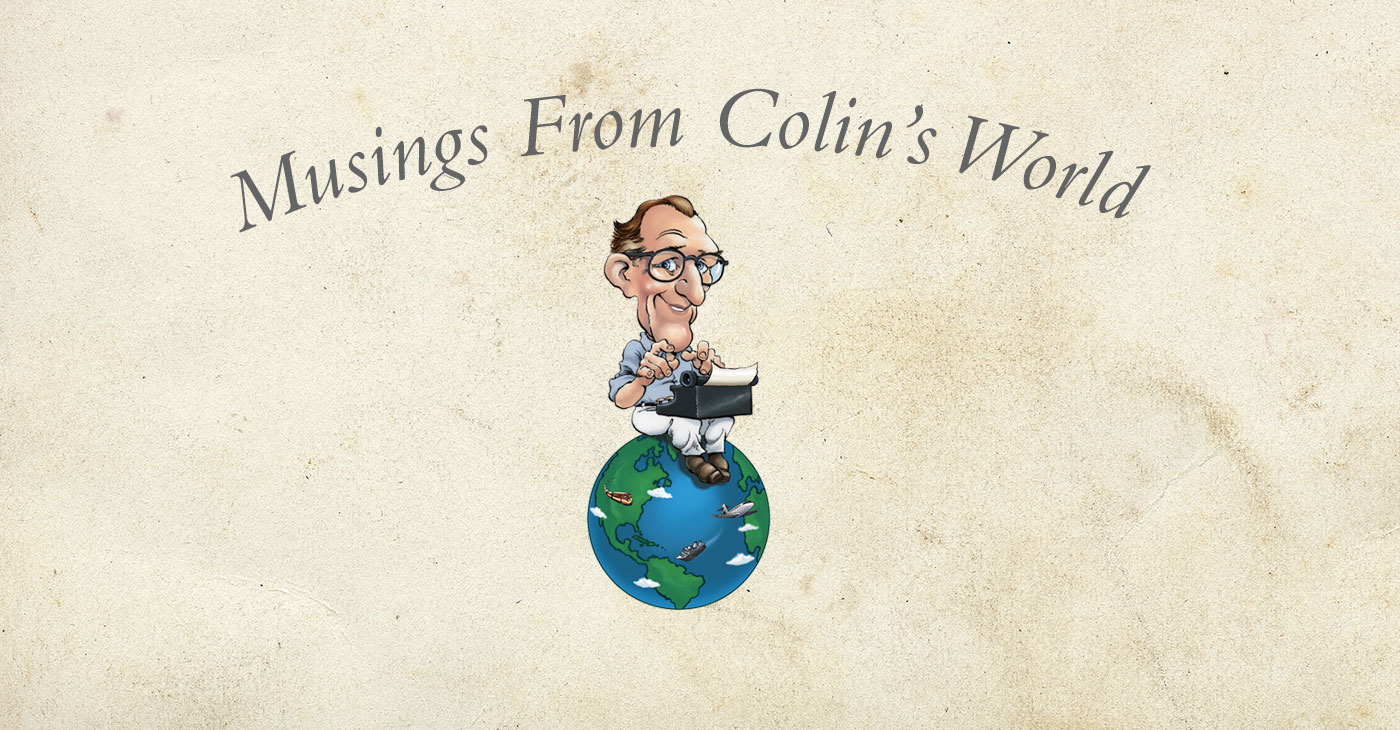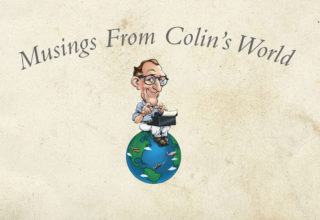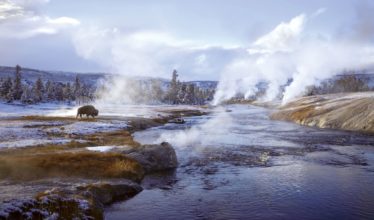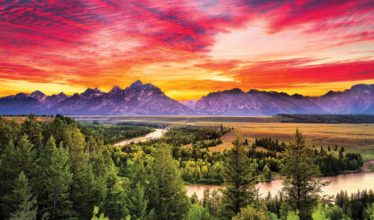It was the week of the full moon when I took the tour of Yellowstone in winter, and with the moon reflecting brightly from mountains blanketed with snow, it was as exotic as any place I have ever seen. It was an enchanted world, so drastically different from my customary frame of reference it was as if I’d been transported to another planet, or perhaps another time.
It’s right here in the Continental USA, only a long day’s drive from where I grew up. But it is otherworldly. Because Yellowstone was set aside and protected as the first national park, we can see it today much as it looked to the first European colonists who cast their wondering eyes upon it in the early 19th century.
Even if you have been to Yellowstone during the summer, you have a completely different experience awaiting you in winter. It is a different place.
Yellowstone in winter is a fantasy wonderland. One of the reasons it is so different in winter is that there are few people there at that time of year. The overwhelming majority of visitors go during summer vacation. From November to May, there are only a few.
Draped in blue-white snow against the big Western sky, the mountainous landscape becomes a thing of overwhelming majesty. It is hard to believe it is the same planet we inhabit when we’re back in the cities.
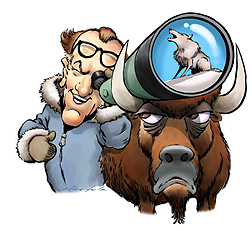 With fewer people, the wild animals have more space, more privacy and freedom to behave naturally. It is a great time to see them. The experience of seeing wild animals in their natural state, behaving spontaneously with virtually no human intervention, is an exhilarating experience.
With fewer people, the wild animals have more space, more privacy and freedom to behave naturally. It is a great time to see them. The experience of seeing wild animals in their natural state, behaving spontaneously with virtually no human intervention, is an exhilarating experience.
Yellowstone’s thermal activity is even more spectacular in winter than in summer. Sitting on the world’s largest volcano, Yellowstone has more thermal activity than anywhere else, from squirting geysers such as Old Faithful to bubbling pools of strangely colored chemical solutions. In the winter when the steaming liquid meets the cold surface air it congeals into clouds of steam that hang densely in the atmosphere over the snowy landscape, creating a scene that looks like it might be on some distant planet.
My group of 20 people spent several days exploring the park with expert guides who live and breathe the park. We traveled in specially equipped snow coaches with giant tires four feet high with deep treads. It was a safari in the American wilderness that led through a series of breathtaking natural settings and points of historical interest, all the while on the hunt for wild animal sightings.
The animals are the protagonists in the great wilderness drama. But while we were intent on finding animals, we were taking in the entire scene. The vast, mountainous landscape upon which the animals live is perhaps too much for the human mind to assimilate. We don’t know how to respond to something of such grand scale. So we focus on details as we drink in the majesty of the vast sky and landscape.
Our tour director warned us that Wednesday would be our coldest day and to be sure to wear layers. When we gathered at the front of our hotel to board our two snow coaches the temperature was in the single digits Fahrenheit. It was not windy, but the cold was penetrating. It began to numb my toes after only a few minutes outside during our first stop for wildlife sightings. But it didn’t last because our periods out in the cold alternated with time warming up in the coach as we moved to our next stop.
After the sun came up, it quickly warmed the land and air. We were never outside long enough at one time for the cold to penetrate my layers of clothing.
We started around dawn, the best time to spot the animals that are active at night and gradually disappear from the landscape after the sun rises. We were looking for whatever wildlife our guides could manage to find for us.
Yellowstone has a great variety of fascinating wildlife, including some large and charismatic species, such as grizzly bears and moose. There are black bears in the park as well, not as big as the grizzlies, but big enough. Since the bears hibernate in the winter, our guides told us we would probably not see any. But because of the warming temperatures some of the bears had been reported to be coming out of hibernation early, so there was a possibility.
The park is home to three kinds of cats: bobcats, lynx and cougar. But they are elusive and it’s rare to see them. In the dog family we fared better. We saw all three indigenous canines: foxes, coyotes and wolves, all beautiful to observe in the wild. The wolves in particular have a spellbinding presence.
After driving for 15 minutes from the hotel, we pulled over and got out to look out over a broad, snow-covered plain, where we could see elk and wolves.
We observed the animals from a distance, but binoculars and spotting scopes provided by our guides, brought them up close. The park regulations tell you to stay 25 yards from the grazing animals and 50 yards from the predators. To my taste 50 yards from a grizzly would be plenty close enough. I’ve heard they could close that distance pretty quickly.
Bison are about the most populous of the large animals in the park and we saw many of them, often quite close. Though they are not predators, they are formidable creatures and you do not want to get close to them if you value your life. Many people make the mistake of underestimating them and some of them get gored.
The bison are enormous and powerful. The bulls are a force of nature not to be trifled with. They are practically all muscle, with massive, mighty shoulders and slim, powerful haunches. I heard that they can leap 18 feet in the air without a run. They grow as large as six feet tall, 10 feet long and can weigh a ton.
We saw one bull leap into the air, throwing a bucking tantrum as one of the coaches edged slowly by, perhaps a little too close for the bison’s comfort. It leaped and whipped around in a stunning explosion of power that would certainly have been deadly to anyone who had been within range of its kicks.
We pulled up near the foot of a cliff where several longhorn sheep were grazing on a terrain so steep it seemed almost vertical. The agile sheep pranced on it with great agility, as easily as if it had been flat ground.
Though these longhorns are called sheep, they have little in common with the domestic sheep we think of when we talk about being “sheepish” or “sheeplike.” They are powerful, confident, graceful and independent animals. They are no one’s sheep but their own.
Their heads are crowned with rolled back horns like those of the ram that is the symbol of the astrological sign of Aries. Their bony heads are the embodiment of pure toughness. The young bucks run at each other and butt their heads together with great force just for sport, or to establish dominance.
As we drove across the landscape, the guides kept watch for wildlife, and when anyone would spot any animals we would stop to try to get a look. The guides had that almost superhuman visual acuity that is developed by outdoor guides who become intimate with wilderness areas. They can spot an animal that would only appear as an unnoticeable spot on the landscape to a visitor.
We saw a wolf walking across a snowy ridge fifty feet above us, silhouetted against a deep blue sky. The sight was riveting, the figure of the wolf, walking nobly and gracefully with its thick silvery coat gleaming in the sun, and marbleized eyes that seemed to stare at us across a gulf of eons.
When the sun was almost to its peak, our guide pulled over to show us a pair of mountain goats he had spotted on top of a ridge across a river from us. With the sun illuminating the luxuriant white hair of the mountain goats they glowed like suns on the ridgetop.
Later in the afternoon when the sun was low and created long shadows on the plain, we spotted a red fox and stopped to watch. In the late afternoon sun the fox’s thick coat glowed reddish orange as it padded stealthily across the crust of snow. Our guide pointed out that it was stalking. It cocked its head as it listened to the movements of a mouse hidden down a hole in the snow.
Focused intently on the hole, the fox gathered itself together and then leapt four feet straight up in the air and came down in a swan dive with its snout aimed precisely at the mouse hole.
After plunging into the snow, the fox emerged with the mouse dangling from its jaws, and what seemed to be a satisfied expression as it crunched down the delicacy.
A series of such experiences gradually altered our consciousness. We increasingly felt a part of the grand procession of nature in the park.
It deepened the experience for me to have recently seen Ken Burns’ film series “The National Parks, America’s Best Idea.” The history that is lovingly presented in the films amplified the experience and helped me to appreciate many layers of meaning that would have otherwise passed me by.
I felt that I was partaking in Yellowstone’s unfathomable beauty and experiencing the joy of discovery much as the first people who ever saw these sights must have. It reminded me of the quote by John Muir that opens the Ken Burns film:
“And here … one learns that the world, though made, is yet being made; that this is still the morning of creation.”
My wish for you is that you may also enjoy the morning of creation.
For now, I bid you farewell.
Your humble reporter,
A. Colin Treadwell
